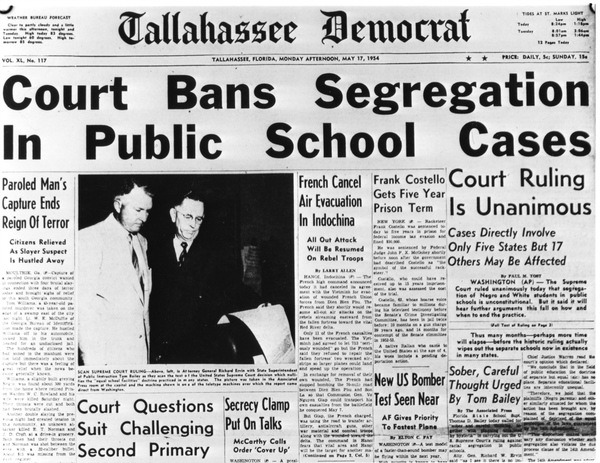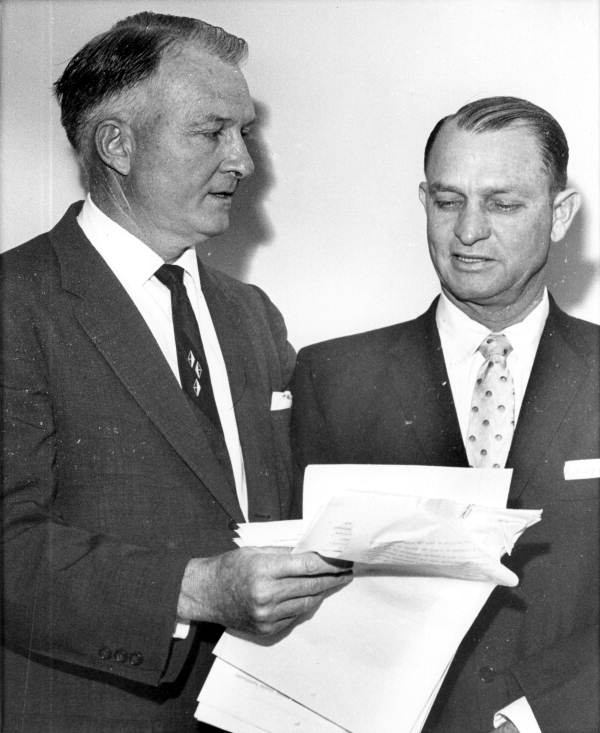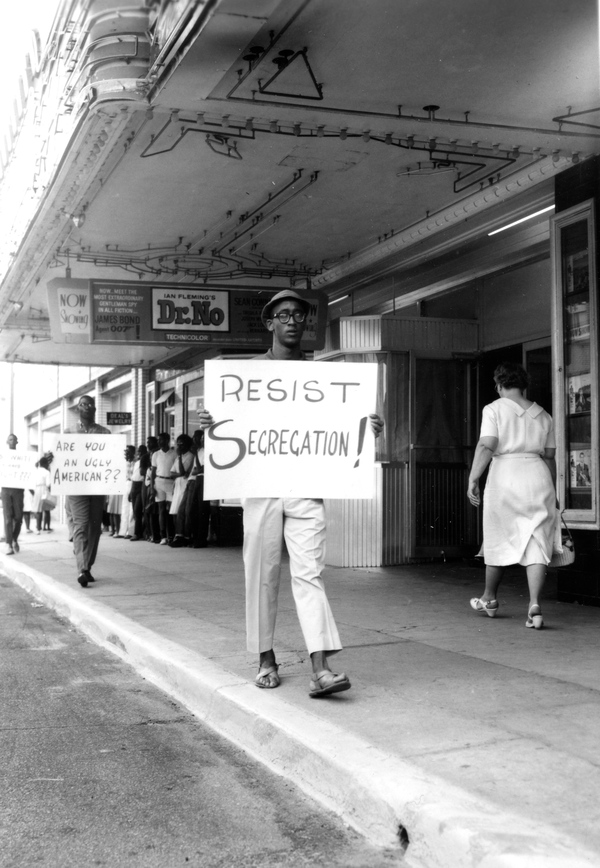Description of previous item
Description of next item
Richard Ervin and the Gradualist Approach to Desegregation
Published July 7, 2014 by Florida Memory
On May 12, 1955, Florida Attorney General Richard Ervin submitted an amicus curiae brief to the United States Supreme Court proposing a gradual approach to school integration. The court had just recently ruled in the case of Brown v. Board of Education in May 1954 that racially segregated schools were unconstitutional.

Headline in the Tallahassee Democrat, the day the U.S. Supreme court issued its opinion that separate schools were inherently unequal and therefore unconstitutional (17 May 1954). State Archives of Florida, Florida Memory.
The court chose to shelve the case for a year, citing a need for further study on how best to implement the decision. Sensing an opportunity to preserve segregation, acting Florida Governor Charley Johns enlisted the expertise of Attorney General Ervin, State Superintendent of Education Thomas D. Bailey, and Florida State University sociologist Lewis Killian to compile a report outlining the “practical problems involved [with desegregation] and recommendations” for implementation. The Florida Cabinet approved a $10, 000 budget for the study, which began in the summer of 1954. Killian began by seeking the opinions of elected officials, journalists, educators, and police chiefs on the subject. Approximately 8,000 surveys reached a biracial sample of community leaders, with a total response rate of fifty one percent.

Atty. Gen. Richard Ervin (left), with Rep. Ben Hill Griffin of Polk County (right). Griffin was chairman of a committee devising legislation allowing parents to withdraw their children from integrated schools (1959). State Archives of Florida, Florida Memory
The responses from African-Americans revealed several prevalent fears associated with desegregating Florida’s public schools, including “withdrawal of white children from the public schools, the maintenance of discipline in mixed classes by Negro [sic.] teachers, refusal to employ Negro teachers for mixed schools, and difficulty in obtaining white teachers” as the “outstanding potential problems found to be expected.” White responses emphasized similar concerns over such matters as maintaining discipline in mixed classrooms, questionable cooperation of white parents, and violent outbreaks. In a telling statistic, seventy-five percent of African-American participants supported the Brown ruling and believe the majority of whites did also. In contrast, a similar percentage of whites thought blacks largely supported segregation. Armed with Killian’s results, Attorney General Ervin made a strong case for gradualism. After a year of delay, the United States Supreme Court reconvened in spring 1955 to clarify the federal enforcement of desegregation in a session aptly nicknamed Brown II. The court considered the research of ten states regarding school desegregation, lauding Attorney General Ervin’s brief as a particularly strong resource. On May 31, 1955, after much deliberation, the justices handed down their decision. The court mandated that compliance with the Brown decision should occur with “a prompt and reasonable start,” carried out with “all deliberate speed.” The vague language coupled with Ervin’s push for gradualism foreshadowed the long battle for school desegregation in post-Brown Florida.

The slow pace of social change in Florida prompted many African-Americans to take action. In the above picture, dated 1962, young men and women stand outside the Florida Theatre in Tallahassee, calling on white America to reevaluate racial segregation. Eight years after the Brown decree only a handful of school districts in Florida were desegregated. Miami-Dade was the first in 1959. State Archives of Florida, Florida Memory.
Cite This Article
Chicago Manual of Style
(17th Edition)Florida Memory. "Richard Ervin and the Gradualist Approach to Desegregation." Floridiana, 2014. https://www.floridamemory.com/items/show/295189.
MLA
(9th Edition)Florida Memory. "Richard Ervin and the Gradualist Approach to Desegregation." Floridiana, 2014, https://www.floridamemory.com/items/show/295189. Accessed January 1, 2026.
APA
(7th Edition)Florida Memory. (2014, July 7). Richard Ervin and the Gradualist Approach to Desegregation. Floridiana. Retrieved from https://www.floridamemory.com/items/show/295189

 Listen: The Assorted Selections Program
Listen: The Assorted Selections Program